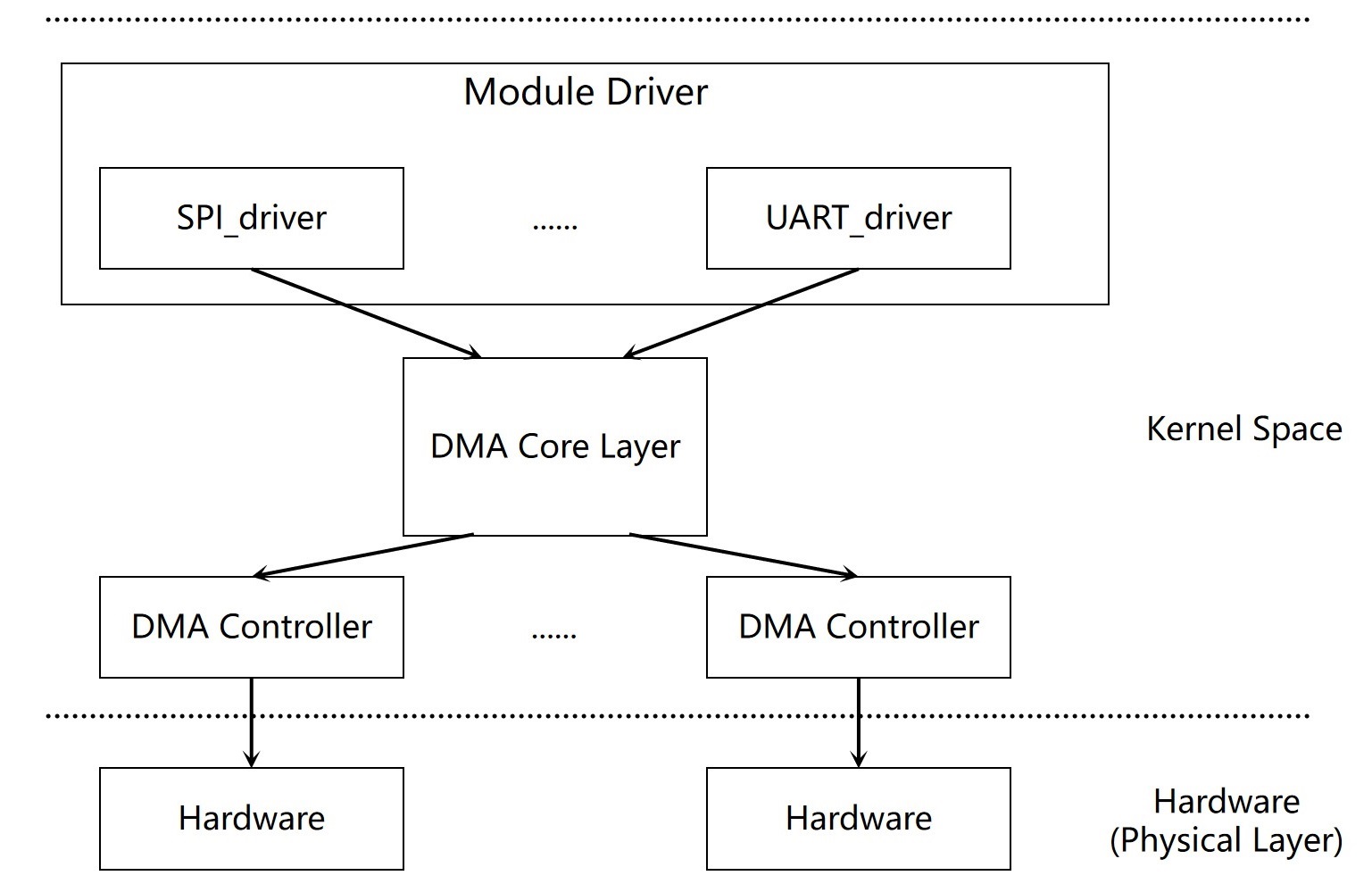DMA
DMA Controller Configuration and DMA Slave Usage Guide.
Overview
DMA (Direct Memory Access) is a method that allows data transfer between source and destination without direct CPU control, by establishing a hardware pathway for data movement. This module implements the DMA controller (DMA master) functionality, is responsible for connecting DMA channels and completing data transfers.
Functional Description
Through the Linux DMA framework with K1-specific DMA controller drivers, three types of data transfer directions are implemented: memory-to-memory, memory-to-peripheral, and peripheral-to-memory. Additionally, memory transfer, scatter-gather list transfer, and circular buffer transfer are supported.
Source Code Structure
The DMA controller driver code is located in the drivers/dma directory:
drivers/dma
|-- dmaengine.c dmaengine.h # Kernel DMA framework code
|-- dmatest.c # Kernel DMA test code
|-- mmp_pdma_k1x.c # K1 DMA controller driver
Key Features
Features
- Supports memory-to-memory, memory-to-peripheral, and peripheral-to-memory transfers.
- 16 DMA channels available.
- Burst sizes supported: 8, 16, 32, 64.
- Maximum transfer size per descriptor: 8191 bytes.
Performance Parameters
The maximum speed for memory-to-memory data transfer using DMA is 220MB/s.
Testing Method:
- You can use the
dmatest.ctool for testing. For specific usage methods, refer to the debugging section below.
Configuration
It mainly includes driver enablement configuration and DTS configuration.
CONFIG Configuration
CONFIG_DMADEVICES
This option provides support for the kernel platform DMA framework. For supporting the K1 DMA driver, this should be set to Y.
Symbol: DMADEVICES [=y]
Device Drivers
-> DMA Engine support (DMADEVICES [=y])
After enabling the platform layer DMA framework, set CONFIG_MMP_PDMA_SPACEMIT_K1X to Y to support the K1 DMA controller driver.
Symbol: MMP_PDMA_SPACEMIT_K1X [=y]
->Spacemit mmp_pdma support (MMP_PDMA_SPACEMIT_K1X [=y])
DTS Configuration
DMA operation requires channel selection and specifies the source and destination addresses, such as memory-to-memory or memory-to-peripheral transfers. Therefore, this section introduces the DTS configuration for enabling the DMA controller and the DTS configuration for other devices like UART when they use DMA.
DMA Controller Configuration
You can refer to the arch/riscv/boot/dts/spacemit/k1-x.dtsi file in the Linux repository for the DMA node configuration, as shown below:
pdma0: pdma@d4000000 {
compatible = "spacemit,pdma-1.0";
reg = <0x0 0xd4000000 0x0 0x4000>;
interrupts = <72>;
interrupt-parent = <&intc>;
clocks = <&ccu CLK_DMA>;
resets = <&reset RESET_DMA>;
#dma-cells= <2>;
#dma-channels = <16>;
max-burst-size = <64>;
reserved-channels = <15 45>;
power-domains = <&power K1X_PMU_BUS_PWR_DOMAIN>;
clk,pm-runtime,no-sleep;
cpuidle,pm-runtime,sleep;
interconnects = <&dram_range4>;
interconnect-names = "dma-mem";
status = "ok";
};
This node configures the DMA's clock and reset resources, the number of channels, the maximum burst size, and reserves channel 15 for the device with peripheral request line 45.
DMA Slave Configuration Example
Here, we use UART0 as an example. Add the following properties under the UART0 node. The macros DMA_UART0_RX and DMA_UART0_TX are defined in the include/dt-bindings/dma/k1x-dmac.h file.
dmas = <&pdma0 DMA_UART0_RX 1
&pdma0 DMA_UART0_TX 1>;
dma-names = "rx", "tx";
Interface
API
The Linux kernel provides a set of APIs for managing DMA operations, including requesting DMA channels, configuring DMA transfers, preparing resources, starting transfers, and more. Here are the commonly used APIs:
// Request a DMA channel
struct dma_chan *dma_request_chan(struct device *dev, const char *name);
// Configure channel parameters, such as transfer width, data size, and source/destination addresses
static inline int dmaengine_slave_config(struct dma_chan *chan,
struct dma_slave_config *config);
// The following three interfaces prepare resources before starting a DMA transfer
dmaengine_prep_dma_memcpy(struct dma_chan *chan, dma_addr_t dest, dma_addr_t src, size_t len, unsigned long flags);
dmaengine_prep_slave_sg(struct dma_chan *chan, struct scatterlist *sgl, unsigned int sg_len, enum dma_transfer_direction direction, unsigned long flags);
dmaengine_prep_dma_cyclic(struct dma_chan *chan, dma_addr_t buf_addr, size_t buf_len, size_t period_len, enum dma_transfer_direction direction, unsigned long flags);
// Add the descriptor to the transfer task list
static inline dma_cookie_t dmaengine_submit(struct dma_async_tx_descriptor *desc);
// Start the transfer
static inline void dma_async_issue_pending(struct dma_chan *chan);
// Release the DMA channel
static inline void dma_release_channel(struct dma_chan *chan);
// Terminate all transfers, for example, pausing during audio playback
static inline int dmaengine_terminate_all(struct dma_chan *chan);
Testing
Since data transfers from memory to device or from device to memory require coordination with the peripheral driver — for example, when UART0 transmits data, the data must be transferred via DMA from memory to the UART TX FIFO, and DMA must be triggered by the UART — testing typically focuses on memory-to-memory transfers. This allows the use of the kernel’s built-in dmatest.c program directly
echo dma0chan8 > /sys/module/dmatest/parameters/channel # Select an unused channel
echo 1 > /sys/module/dmatest/parameters/iterations # Set the number of transfers, using 1 as an example
echo 4096 > /sys/module/dmatest/parameters/transfer_size # Set the transfer data size (not exceeding 16k)
echo 1 > /sys/module/dmatest/parameters/run # Start the transfer
First, enable the kernel configuration option CONFIG_DMATEST. After generating the new firmware, boot into the kernel.
